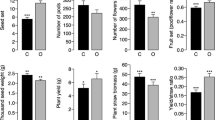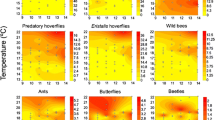Abstract
Pollinators are beneficial for many wild and crop plants. As a mass-flowering crop, oilseed rape has received much focus in terms of its pollination requirements but despite a threefold increase in area of cultivation of this crop in Ireland over the past 5 years, little is known about its pollination here. We surveyed the flower visiting insects found in commercial winter oilseed rape fields and evaluated the importance of different pollinator groups, investigated the contribution of insect pollination to oilseed rape seed production, and estimated the economic value of insect pollination to the crop at a national level. Our data showed that winter oilseed rape is visited by a wide variety of insect species, including the honeybee, bumblebees, solitary bees, and hoverflies. The honeybee, Eristalis hoverflies and bumblebees (especially Bombus sensu stricto and B. lapidarius) were the best pollinators of winter oilseed rape based on the number of pollen grains they carry, visitation rates per flower and their relative abundance per field. Exclusion of pollinators resulted in a 27 % decrease in the number of seeds produced, and a 30 % decrease in seed weight per pod in winter crops, with comparable values from a spring oilseed rape field also. The economic value of insect pollination to winter oilseed rape was estimated as €2.6 million per annum, while the contribution to spring oilseed rape was €1.3 million, resulting in an overall value of €3.9 million per annum. We can suggest the appropriate conservation and management of both honeybees and wild pollinators in agricultural areas to ensure continued provision of pollination services to oilseed rape, as a decrease in insect numbers has the potential to negatively influence crop yields.



Similar content being viewed by others
References
Aizen MA, Garibaldi LA, Cunningham SA, Klein AM (2008) Long-term global trends in crop yield and production reveal no current pollination shortage but increasing pollinator dependency. Curr Biol 18(20):1572–1575
Allsopp MH, de Lange WJ, Veldtman R (2008) Valuing insect pollination services with cost of replacement. PLoS ONE 3(9):e3128
Biesmeijer JC, Roberts SPM, Reemer M, Ohlemuller R, Edwards M, Peeters T, Schaffers AP, Potts SG, Kleukers R, Thomas CD, Settele J, Kunin WE (2006) Parallel declines in pollinators and insect-pollinated plants in Britain and the Netherlands. Science 313(5785):351–354
Bommarco R, Marini L, Vaissière B (2012) Insect pollination enhances seed yield, quality, and market value in oilseed rape. Oecologia 169:1025–1032
Breeze TD, Bailey AP, Balcombe KG, Potts SG (2011) Pollination services in the UK: How important are honeybees? Agric Ecosyst Environ 142(3–4):137–143
Brittain C, Williams N, Kremen C, Klein A-M (2013) Synergistic effects of non-Apis bees and honey bees for pollination services. Proc R Soc B Biol Sci 280(1754):20122767
Bullock C, Kretsch C, Candon E (2008) The economic and social aspects of biodiversity. Benefits and costs of biodiversity in Ireland. Department of Environment, Heritage and Local Government, Dublin
Carolan JC, Murray TE, Fitzpatrick Ú, Crossley J, Schmidt H, Cederberg B, McNally L, Paxton RJ, Williams PH, Brown MJF (2012) Colour patterns do not diagnose species: quantitative evaluation of a DNA barcoded cryptic bumblebee complex. PLoS ONE 7(1):e29251
Carvalheiro LG, Seymour CL, Nicolson SW, Veldtman R (2012) Creating patches of native flowers facilitates crop pollination in large agricultural fields: mango as a case study. J Appl Ecol 49(6):1373–1383
CSO (2009) Area, yield and production of crops 2009. Central Statistics Office of Ireland. http://www.cso.ie/en/media/csoie/releasespublications/documents/agriculture/2009/aypcrop_2009.pdf
CSO (2010) Area, yield and production of crops 2010. Central Statistics Office. http://www.cso.ie/en/media/csoie/releasespublications/documents/agriculture/2010/aypcrop_2010.pdf
CSO (2011a) Area, yield and production of crops 2011. Central Statistics Office of Ireland. http://www.cso.ie/en/media/csoie/releasespublications/documents/agriculture/2011/aypcrop_2011.pdf
CSO (2011b) Crops and livestock survey. Central Statistics Office of Ireland
Dafni A, Kevan PG, Husband BC (2005) Practical pollination biology. Enviroquest Ltd., Cambridge
Eilers EJ, Kremen C, Greenleaf SS, Garber AK, Klein AM (2011) Contribution of pollinator-mediated crops to nutrients in the human food supply. PLoS ONE 6(6):e21363
Gallai N, Salles JM, Settele J, Vaissiere BE (2009) Economic valuation of the vulnerability of world agriculture confronted with pollinator decline. Ecol Econ 68(3):810–821
Garibaldi LA, Steffan-Dewenter I, Kremen C, Morales JM, Bommarco R, Cunningham SA, Carvalheiro LG, Chacoff NP, Dudenhoffer JH, Greenleaf SS, Holzschuh A, Isaacs R, Krewenka K, Mandelik Y, Mayfield MM, Morandin LA, Potts SG, Ricketts TH, Szentgyorgyi H, Viana BF, Westphal C, Winfree R, Klein AM (2011) Stability of pollination services decreases with isolation from natural areas despite honey bee visits. Ecol Lett 14(10):1062–1072
Garibaldi LA, Steffan-Dewenter I, Winfree R, Aizen MA, Bommarco R, Cunningham SA, Kremen C, Carvalheiro LG, Harder LD, Afik O, Bartomeus I, Benjamin F, Boreux V, Cariveau D, Chacoff NP, Dudenhöffer JH, Freitas BM, Ghazoul J, Greenleaf S, Hipólito J, Holzschuh A, Howlett B, Isaacs R, Javorek SK, Kennedy CM, Krewenka KM, Krishnan S, Mandelik Y, Mayfield MM, Motzke I, Munyuli T, Nault BA, Otieno M, Petersen J, Pisanty G, Potts SG, Rader R, Ricketts TH, Rundlöf M, Seymour CL, Schüepp C, Szentgyörgyi H, Taki H, Tscharntke T, Vergara CH, Viana BF, Wanger TC, Westphal C, Williams N, Klein AM (2013) Wild pollinators enhance fruit set of crops regardless of honey bee abundance. Science 339(6127):1608–1611
Greenleaf SS, Kremen C (2006) Wild bees enhance honey bees’ pollination of hybrid sunflower. Proc Natl Acad Sci USA 103(37):13890–13895
Haenke S, Scheid B, Schaefer M, Tscharntke T, Thies C (2009) Increasing syrphid fly diversity and density in sown flower strips within simple vs. complex landscapes. J Appl Ecol 46(5):1106–1114
Hayter KE, Cresswell JE (2006) The influence of pollinator abundance on the dynamics and efficiency of pollination in agricultural Brassica napus: implications for landscape-scale gene dispersal. J Appl Ecol 43(6):1196–1202
Hoehn P, Tscharntke T, Tylianakis JM, Steffan-Dewenter I (2008) Functional group diversity of bee pollinators increases crop yield. Proc R Soc B Biol Sci 275(1648):2283–2291
Hothorn T, Bretz F, Westfall P (2008) Simultaneous inference in general parametric models. Biom J 50(3):346–363
Hudewenz A, Pufal G, Bogeholz A-L, Klein A-M (2013) Cross-pollination benefits differ among oilseed rape varieties. J Agric Sci. doi:10.1017/S0021859613000440
Jacobs JH, Clark SJ, Denholm I, Goulson D, Stoate C, Osborne JL (2009) Pollination biology of fruit-bearing hedgerow plants and the role of flower-visiting insects in fruit-set. Ann Bot 104(7):1397–1404
Jauker F, Wolters V (2008) Hover flies are efficient pollinators of oilseed rape. Oecologia 156(4):819–823
Jauker F, Bondarenko B, Becker HC, Steffan-Dewenter I (2012) Pollination efficiency of wild bees and hoverflies provided to oilseed rape. Agric For Entomol 14(1):81–87
Klein AM, Vaissiere BE, Cane JH, Steffan-Dewenter I, Cunningham SA, Kremen C, Tscharntke T (2007) Importance of pollinators in changing landscapes for world crops. Proc R Soc B Biol Sci 274(1608):303–313
Klein AM, Cunningham SA, Bos M, Steffan-Dewenter I (2008) Advances in pollination ecology from tropical plantation crops. Ecology 89(4):935–943
Kremen C, Williams NM, Thorp RW (2002) Crop pollination from native bees at risk from agricultural intensification. Proc Natl Acad Sci USA 99(26):16812–16816
Le Feon V, Burel F, Chifflet R, Henry M, Ricroch A, Vaissiere BE, Baudry J (2013) Solitary bee abundance and species richness in dynamic agricultural landscapes. Agric Ecosyst Environ 166:94–101
Leroy PD, Verheggen FJ, Capella Q, Francis F, Haubruge E (2010) An introduction device for the aphidophagous hoverfly Episyrphus balteatus (De Geer) (Diptera: Syrphidae). Biol Control 54(3):181–188
Morandin LA, Winston ML (2005) Wild bee abundance and seed production in conventional, organic, and genetically modified canola. Ecol Appl 15(3):871–881
O’Donovan T, O’Mahony J (2011) Crops costs and returns. Teagasc; Agriculture and food development authority. http://www.teagasc.ie/publications/2011/58/58_CropReport_Jan2011.pdf
Ollerton J, Winfree R, Tarrant S (2011) How many flowering plants are pollinated by animals? Oikos 120(3):321–326
O’Mahony J (2009) Crops costs and returns. Teagasc; Agriculture and food development authority
O’Mahony J, O’Donovan T (2010) Crops costs and returns. Teagasc; Agriculture and food development authority. http://www.teagasc.ie/publications/2010/12/12_CropsCostsReturns2010Final_20jan10.pdf
Pinheiro J, Bates D, DebRoy S, Sarkar D, R Development Core Team (2012) Package “nlme”: linear and nonlinear mixed effects models. R package version 3.1-104
Power EF, Stout JC (2011) Organic dairy farming: impacts on insect-flower interaction networks and pollination. J Appl Ecol 48(3):561–569
R Development Core Team (2011) R: a language and environment for statistical computing. R Foundation for Statistical Computing, Vienna, Austria. URL http://www.R-project.org
Rader R, Howlett BG, Cunningham SA, Westcott DA, Newstrom-Lloyd LE, Walker MK, Teulon DAJ, Edwards W (2009) Alternative pollinator taxa are equally efficient but not as effective as the honeybee in a mass flowering crop. J Appl Ecol 46(5):1080–1087
Rader R, Howlett BG, Cunningham SA, Westcott DA, Edwards W (2012) Spatial and temporal variation in pollinator effectiveness: do unmanaged insects provide consistent pollination services to mass flowering crops? J Appl Ecol 49(1):126–134
Sabbahi R, De Oliveira D, Marceau J (2005) Influence of honey bee (Hymenoptera: Apidae) density on the production of canola (Crucifera: Brassicacae). J Econ Entomol 98(2):367–372
Sabbahi R, de Oliveira D, Marceau J (2006) Does the honeybee (Hymenoptera: Apidae) reduce the blooming period of canola? J Agron Crop Sci 192(3):233–237
Stanley DA, Stout JC (2013) Quantifying the impacts of bioenergy crops on pollinating insect abundance and diversity: a field-scale evaluation reveals taxon-specific responses. J Appl Ecol 50(2):335–344
Stanley DA, Knight ME, Stout JC (2013) Ecological variation in response to mass-flowering oilseed rape and surrounding landscape composition by members of a cryptic bumblebee complex. PLoS ONE 8(6):e65516
Thomson JD, Goodell K (2001) Pollen removal and deposition by honeybee and bumblebee visitors to apple and almond flowers. J Appl Ecol 38(5):1032–1044
Westphal C, Bommarco R, Carre G, Lamborn E, Morison N, Petanidou T, Potts SG, Roberts SPM, Szentgyorgyi H, Tscheulin T, Vaissiere BE, Woyciechowski M, Biesmeijer JC, Kunin WE, Settele J, Steffan-Dewemter I (2008) Measuring bee diversity in different European habitats and biogeographical regions. Ecol Monogr 78(4):653–671
Williams IH, Martin AP, White RP (1986) The pollination requirements of oilseed rape (Brassica napus L.). J Agric Sci 106:27–30
Willmer PG, Bataw AAM, Hughes JP (1994) The superiority of bumblebee to honeybees as pollinators—insect visits to raspberry flowers. Ecol Entomol 19(3):271–284
Winfree R, Williams NM, Gaines H, Ascher JS, Kremen C (2008) Wild bee pollinators provide the majority of crop visitation across land-use gradients in New Jersey and Pennsylvania, USA. J Appl Ecol 45(3):793–802
Acknowledgments
We would like to thank the farmers that kindly participated in this study; Alan Matthews for advice on economic valuation; Michael Slawski for providing information on crop yields and values; Oliver Carter for providing information on proportions of spring and winter oilseed rape; Conor Owens for help with field work; Soledad Colombe, James Desaegher and other volunteers for help with weighing and counting seeds; Colm Roynane for identifying solitary bees and type specimens of wasps; and Tom Gittings for verification of type specimens of hoverflies. David Stanley and two anonymous reviewers provided valuable comments on previous versions of this manuscript. This research was funded by the project SIMBIOSYS (www.simbiosys.ie, 2007-B-CD-1-S1) as part of the Science, Technology, Research and Innovation for the Environment (STRIVE) Programme, financed by the Irish Government under the National Development Plan 2007–2013, administered on behalf of the Department of the Environment, Heritage and Local Government by the Irish Environmental Protection Agency (EPA).
Author information
Authors and Affiliations
Corresponding author
Electronic supplementary material
Below is the link to the electronic supplementary material.
Rights and permissions
About this article
Cite this article
Stanley, D.A., Gunning, D. & Stout, J.C. Pollinators and pollination of oilseed rape crops (Brassica napus L.) in Ireland: ecological and economic incentives for pollinator conservation. J Insect Conserv 17, 1181–1189 (2013). https://doi.org/10.1007/s10841-013-9599-z
Received:
Accepted:
Published:
Issue Date:
DOI: https://doi.org/10.1007/s10841-013-9599-z




